STATIC ELECTRICITY, DAILY OCCURRENCES AND APPLICATIONS

image source
Most of us probably haven’t heard of this before, but it’s nothing strange. Be it that feeling you get in a dry and windy day when you wear a light nylon or silk material, or that cracking sensation you get when combing your dry hair on a dry hamattan, or the shock you get on getting out of your vehicle on a dry and windy day and finally what you see on TV when people use the plasma ball. This are all daily occurrences of what am going to explain here today. My post is divided into two: today I will be treating just the following:
• Definition
• Difference from current electricity
• Methods of charging bodies
And then on my next post I will treat:
• Electroscope and electrophorus
• Lightening spikes and other applications of electrostatics.
Definition
Electrostatics or static electricity implies to electric charges at rest. Unlike current electricity this charges possess electrical potential energy, they are not directed by a p.d or E.M.F
Difference from current electricity
Current electricity is the popular form of electrical energy we know and use in our daily activities, for cooking, heating, lighting etc. In this form of charge behaviour, charges are produced and directed in streams of flowing electrons, hence producing a current, but in static electricity no E.M.F is applied to give electrons or charges direction of flow, so their mean motion is zero, that is they are at rest.
Methods of charging a body
• Friction
Friction between two bodies produces charges, which are harnessed to produce vast amount of static electrons.

Pick a rubber Biro, rub the barrel against your dry hair or sleeves(if silky), take it closer to tiny pieces of paper as mine, and observe what happens. Yes, they seem magnetic, aren’t they. That’s the attracting property between the Biro that has acquired a charge opposite to the pieces of paper.
• By induction
When a charged body is brought near an uncharged body, the chargeless fellow gets rid of the kind of charge on the opposite fellow (remember that like charges always repel and vice versa), hence the opposite body attracts the charge opposite it’s own, and if the charge gotten rid of us earthed I.e. Connected to the earth by touching, then the uncharged body is charged opposite the charged body.
Note:
• The body to be charged must be placed on an insulator
• The hands is removed first before taking the inducing body away, otherwise the charge flies back and the uncharged body becomes neutral again.
The final method is best treated with the Electroscope and that’s The contact method, watch out for more on my up coming post. Upvote and resteem if this post was helpful.
Original post from @crystannson

Static electricity was really an interesting thing back in my school days..!!
Ur article is interesting... I would suggest u to add the ource of ur image.. If u need guidance about ur STEM articles, feel free to join our discord server.
Okay, one is from pixabay and others my phone camera
@crystannson, please provide the link to the pixabay image. It will easy for the curators to check if it's under any copyright.
For some reason, your work is not referenced. Are you the originator of all these ideas ?

Am sorry, but it was written from I knowledge I acquired from school, from my lecturer